How attribution models work, why you need them and which one to use.
Contents
-
- The challenge of measuring success
What is attribution modelling?
-
- Attribution explained
Why attribution matters
-
- Why you need attribution modelling
5 attribution models and why you’d use them
-
- Let’s start with a journey
- Which channel did the work?
- #1 Last click
- #1.1 Last non-direct click
- #2 First click
- #3 Linear
- #4 Position based
- #5 Time decay
Making attribution decisions
-
- Choosing the right model
Identifying the need – How do you tell that you need to change the way you’re measuring success?
-
- Assisted conversions
- Analysing the example
How we make better decisions – How attribution modelling and assisted conversions help us to make the right decisions about what to do with your media budget
-
- Hypotheticals and models applied
- Reading the numbers
- Adding in assists
- The bigger picture
Implementing attribution – How can you put attribution modelling into action?
- What we use for attribution modelling
- We’d like to help

Creating a model that properly measures the success of your digital marketing campaigns is one of the biggest challenges we currently face as marketers.
Top of funnel activities generally don’t get the recognition they deserve from traditional measurement methods. That’s why attribution modelling is so important – if you’re going to make decisions about your marketing budget, you need to do it with the right information in hand.
The what, the why and the how
In this guide, we’ll look at what we mean when we say attribution modelling, why it’s so important in the modern digital marketing eco-system, and how changing which model
you use could give you a better understanding of how your marketing channels are performing.
Included are 5 examples of attribution models, with an explanation of how each of those would measure an example conversion journey.
If you want to find out more about how you should be attributing success for your digital campaigns, you’ll find information about a free attribution audit at the end of this guide!

Attribution modelling is all about getting a better understanding of how your marketing channels are performing.
Digital marketing campaigns can be complex, with multiple channels of activity all interwoven and affecting each other. When this is the case, it’s vital you have a measurement model that can take all of this into account.
You are already doing it
In all likelihood, even if you’ve never considered attribution modelling, you are already doing it.
If you’re assigning conversions to different channels – e.g. social media, paid search, display – then you are already attributing.
The model you’re probably using is last click, giving all the credit to the last thing the user clicks through on. While this is better than nothing, last click has its flaws – especially if you are running multiple channels. More on this later!
“An attribution model is the rule, or set of rules, that determines how credit for sales and conversions is assigned to touchpoints in conversion paths.” – Google

Making the right decisions about your digital marketing ultimately comes down to data. What attribution modelling gives you is a better understanding of what your data really means.
Conversion credit where it’s due
Attribution modelling allows you to properly distribute credit for the conversions generated by your digital marketing.
Last click will attribute all of the credit for a conversion to the last channel a user interacted with. That might be paid search, for example.
But what about that brand awareness display campaign you’re running? Under last click, that activity will be showing few, or maybe even zero, conversions. Based on that assessment, you might choose to stop that display campaign.
The reality could be that the above user only searched for your brand because of that display campaign. Therefore, you need an attribution model that identifies and attributes that success – so that you can assess and understand the value of all your marketing.

Before we get into the nitty gritty of our 5 attribution models, let’s take a look at a hypothetical conversion journey.
The diagram below shows this journey.
The user has 4 touchpoints on their path to conversion.
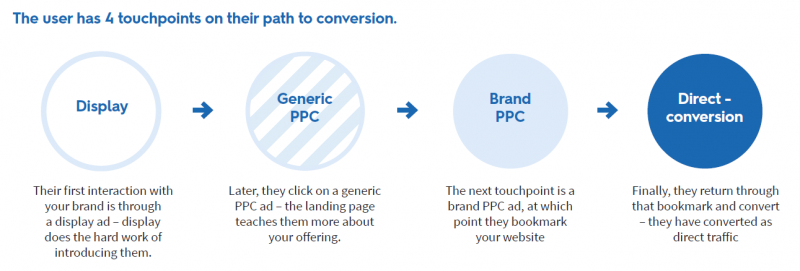

In the example provided, you might have some opinions about which channels should get credit for that conversion and how that credit should be weighted.
However, when we see results in Analytics, for example, we don’t necessarily get such a granular picture of the user journey. If you’re looking at hundreds of conversions, then going into this level of detail simply isn’t practical.
Choosing the right attribution model gives you the ability to report accurately on your conversion journeys.
Understanding the example models
In this section, we’ll use the example journey to explain how the 5 most common attribution models would measure success – where they would attribute the conversion.
In some cases that might be a round number, in that a single channel gets 1 conversion. In other cases, multiple channels might get a portion of the credit – e.g. 0.4 of a conversion.

Last click looks at the interaction that delivered the conversion. Essentially, the channel that makes the sale gets the credit.
Pros
It’s simple and easy to understand.
Cons
Last click doesn’t give any credit to early stages in the journey – the channel that introduces the user, for example, could look like a complete failure with this model.
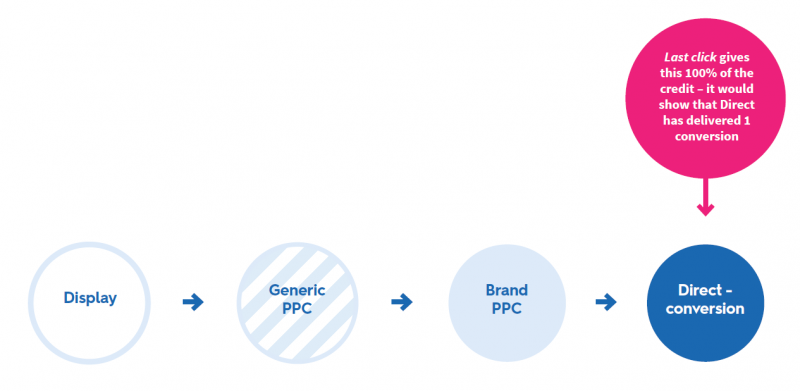

A variation of the last click model, last non-direct click will, as the name suggests, ignore direct if it is the last click and give credit to the
previous interaction. The rationale here being that the user had already been converted by the previous interaction and simply returned directly to complete the action. If direct is the only interaction, it will receive credit.
Pros
It prevents your conversions stacking up as direct, with all your marketing channels showing no success.
Cons
While it helps prevent direct taking all the credit, this model still ignores the earlier parts of the Journey.
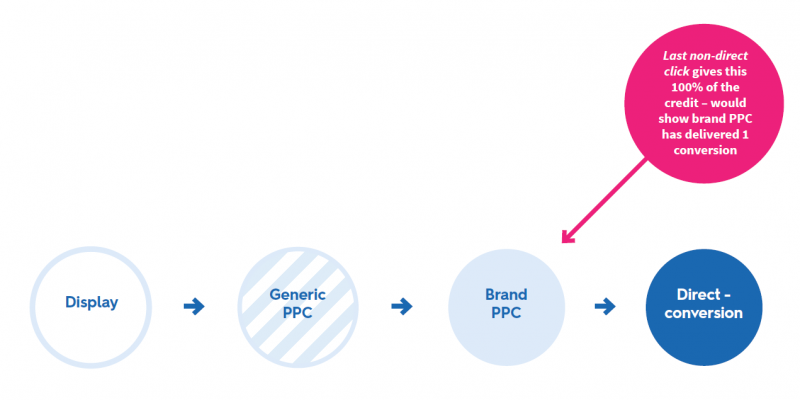

First click does exactly what it says on the tin – it gives the credit to the first interaction the customer had. The rationale here is that this allows you to see which channels are doing the hard work of introducing a user to your brand.
If you want to know which channels are delivering at the top of the funnel, first click will give you the insight you’re after.
Pros
It gives a clear view of what’s driving success at the start of the journey.
Cons
You don’t get a clear look at the middle part of the journey, or of the channels that are closing the sale.
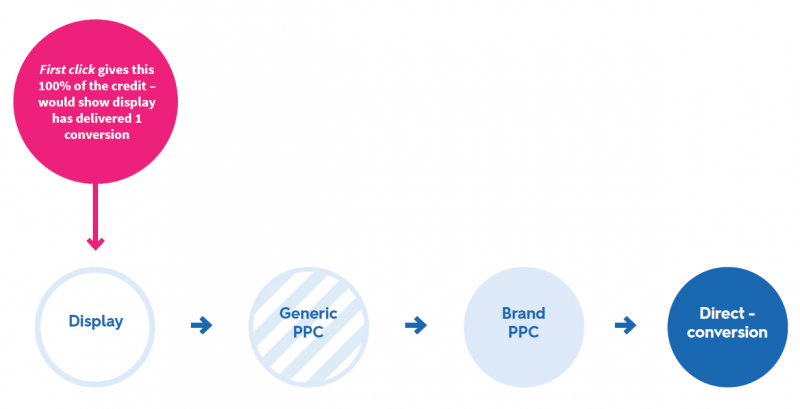

The linear attribution model is designed to recognise all the touchpoints in a conversion journey. It does this by dividing the credit for the conversion equally across all of those interactions.
If there were 5 interactions each would show 0.2 of a conversion, if there were 6 each would show 0.166 and so on. In our example with 4 touchpoints, each would be credited with 0.25 of a conversion.
Pros
It helps you to see which channels are contributing throughout conversion journeys.
Cons
This model doesn’t give you a clear view of which channel is closing the sale – it may not be realistic to say all channels are contributing equally.
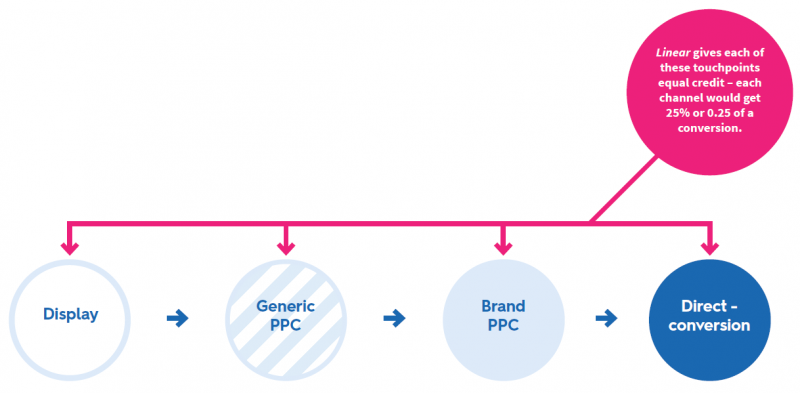

The position based model gives the majority of the credit to the first and final interactions – these get 40% each. The remaining 20% of credit is then spread across the touchpoints in between those two key interactions – the rationale here being that the introduction and conversion are the most important.
Pros
This model gives you a view of the whole conversion journey, while still prioritising the important first and last interactions.
Cons
While this model credits the middle of the journey, it may actually be under-valuing these touchpoints – the reality is that removing them could significantly damage the number of conversions.
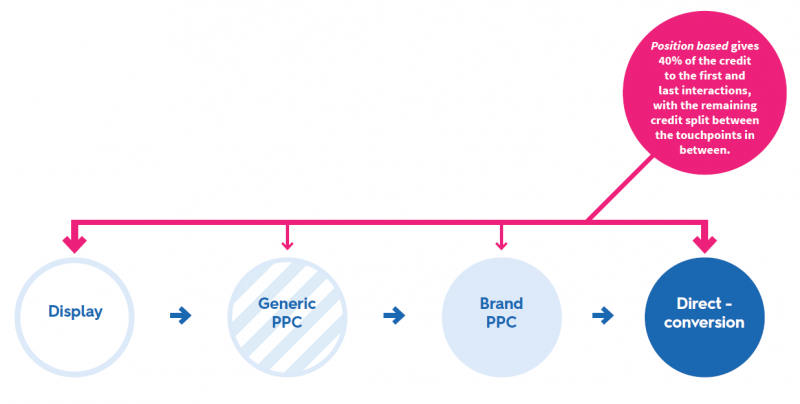

Time decay looks at how long before the conversion each of the touchpoints occurred and attributes success based on this – proportionally less the longer ago they were.
This model is particularly useful if you are running seasonal or sale based activity. You don’t want to cloud your data with old interactions, you want to see how your latest promotion is contributing to your conversions.
Pros
Gives you a view of which touchpoints occurred most frequently in the immediate run up to conversions.
Cons
You could be undervaluing the channels that do the hard work of introducing the user to your brand.
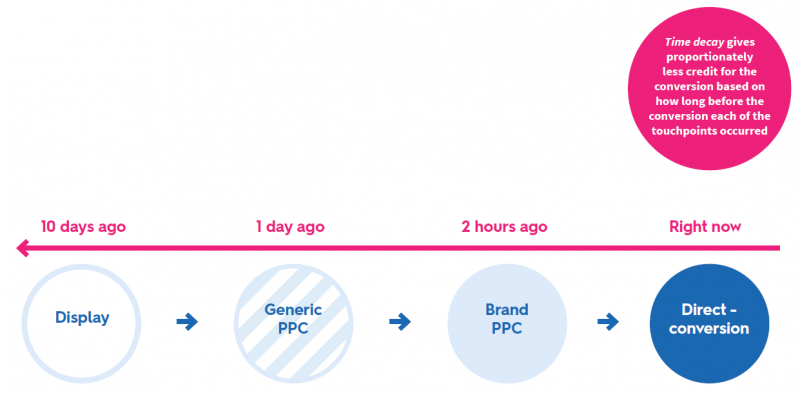

The 5 attribution models described above are some of the most common, but this is by no means an exhaustive list. With each model having pros and cons, it can be difficult to know which one to choose.
When it comes down to making these decisions, there are a few important things to remember…
Be flexible
You don’t have to pick one model and stick to it – you can, and should, change which model you are using depending on the kind of activity you are running.
Tweak and customise
The figures we’ve included in the above models are defaults – but you can, and should, customise these to suit your campaigns. This is how you can get around some of the potential issues identified above.
For example, if you want a view of the whole journey but still give some greater weighting to introduction and conversion, you might want to run position based but with only 30% (instead of 40%) attributed to first and last click, with the rest spread between the other touchpoints.

One of the best ways to tell that you need to look at how you attribute conversion success is to look at assisted conversions.
Assisted conversions is a very basic style of attribution model, in which the last click gets 1 conversion and all other touchpoints get 1 assist.
Returning to our previous 4 channel example, this might give us a chart like the one to the right.
The ratio shows us the role of the channel in your conversion journeys – if the ratio is close to 0 then the channel is last click heavy, if the ratio is over 1 then the channel is assist heavy. If the ratio is close to 1 then the channel is delivering a balance of both.
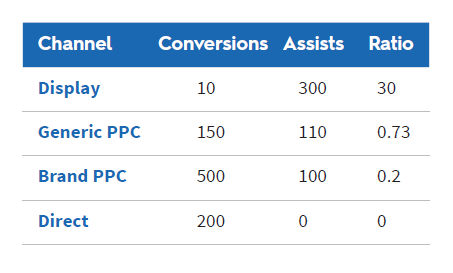

Now, if we’re running a last click attribution model we’d only see 10 conversions from display. If we had a display budget of £10,000 that’d be showing a CPA of £1,000.
Looking at the assists shows us there’s another story we need to understand.
What this means for your marketing
A marketing channel with a CPA of £1,000 doesn’t sound very appealing.
However, if you consider that a high percentage of the direct conversions are only happening due to display assists with some of the brand PPC conversions also being heavily assisted by the channel, it quickly becomes clear that display is extremely valuable.
You can then start to take steps to attribute success to your display campaign. This might mean using the first click model to purely see conversions driven by a first interaction with a display ad, or it might mean using position based to understand the introduction and conversion stages of the journey.

We’ve talked about an example conversion journey and some hypotheticals on how each of the 5 attribution models would credit the touch points in that journey. We’ve also looked at how assisted conversions can help you diagnose a potential attribution problem.
Now it’s time to look at how we applied all of this to a real world situation in order to make the right decisions about your marketing budget and media spend.
The numbers
These numbers are from a real account we manage – all anonymised so that we can really dig into the detail!
These figures are using a default last nondirect click model in Google Analytics.
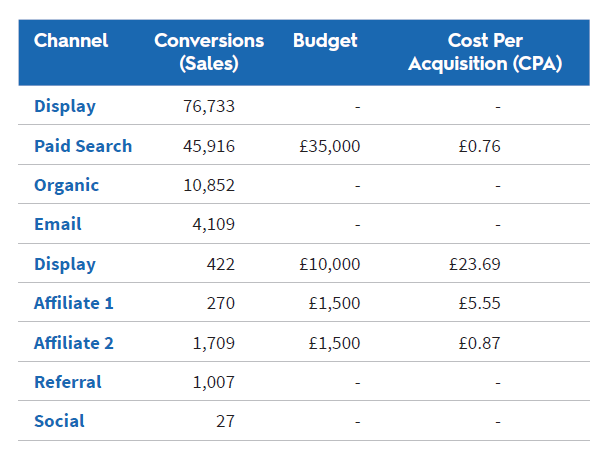

Looking at these numbers, there are a few key takeaways:
- Paid search is driving the best CPA
- Display is delivering a much higher CPA than other paid channels
- Affiliate 2 is significantly outperforming Affiliate 1
Decision time
If you were looking to spend your marketing budget more efficiently, what would you do based on these numbers?
Perhaps you’d consider moving the display budget into PPC and moving Affiliate 1’s budget to Affiliate 2.
Based on the last non-direct click figures, that looks like a smart move. But is that the whole picture?

Before we jump to action, we need to dig deeper into the data.
Looking at assisted conversions gives us the chance to make sure we’re not making the wrong decisions – this is where we look for warning signs that we need a different model.
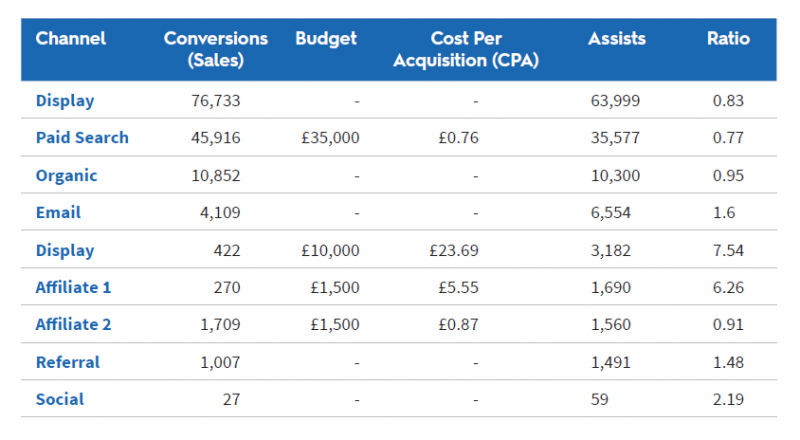

Looking at the assists and the ratios for each channel, we get a better view of what’s happening:
- Display and Affiliate 1 both have ratios significantly higher than 1 – this shows that they are significantly contributing to the success of other channels
- Paid search is more often the last interaction, rather than assisting other channels
- Affiliate 2 is balanced, both converting and assisting in almost equal measure
How this affects our thinking
We now know it’s not as simple as it looked – if we cut Display and Affiliate 1, we could see a downturn in the performance of the channels they are assisting.
Attribution modelling can now help us get a better understanding of how these channels are performing. With all this information in hand, we can now use the following models:
- First Click to see how often Display and Affiliate 1 are doing the hard work of ‘introducing’ – being the first point of interaction in the conversion journey
- Linear or Position Based to get a view of how significant these contributions are – how long are the journeys and how much impact is each touchpoint having?

While Google Analytics is more often than not our starting point for attribution, we use a selection of tools and platforms to get the level of detail we need.
We use tools you may have heard of, like Google Attribution 360 and DoubleClick, as well as bespoke solutions that work with our clients’ analytics platforms.
There are many solutions out there – find the one that works with your analytics platform.
Understanding the strategic implications
Attribution modelling is a double header – you don’t just need to understand how to do it and what it means, but also how to then understand and respond to the information it gives you.
It’s complicated, but that’s the bit we enjoy – when you’re obsessed with data and dedicated to success, then attribution modelling is the perfect discipline. It’s all about finding clues in the data that help you prosper!

We understand that attribution is a big challenge, especially if you’re running multi-channel marketing campaigns.
Our experts are equipped to help you better understand how your marketing is performing throughout the funnel – let’s talk about how we can help you.
Get in touch with Elixirr Digital today!
Download the guide











